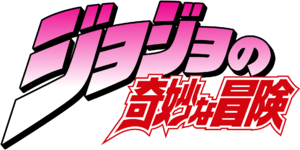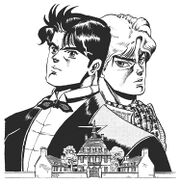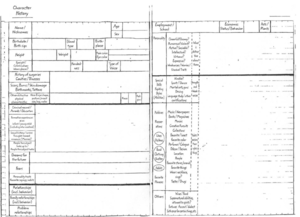JoJo's Bizarre Adventure/pt-br
Perfil
JoJo foi serializado no Weekly Shonen Jump de 1987[1] até 2004, quando foi então transferido para a revista seinen mensal Ultra Jump, onde a história atual continua. A série é colecionada em uma variedade de formatos dos Tankōbons padrões aos volumes de edição especial como os Bunkobans e os Kanzenbans todos dos quais contém o manga como foi serializado no Weekly Shonen Jump e Ultra Jump com algumas diferenças como nomes diferentes de capítulos e mudanças de dialogo.
A série tem mais de 100 milhões de cópias impressas,[2] fazendo dela uma das séries de mangás mais vendidas da história. Tendo mais de 120 volumes, é a segunda mais longa série de mangá da Shueisha. A publicação das partes anteriores em inglês, português e outros idiomas estão em andamento.
O gênero de JoJo abrange Ação, Aventura, Sobrenatural, Suspense, Comédia, Tragédia, Mistério, Slice of Life, e Terror. É talvez mais popularmente conhecido pelo fenômeno de Stands; O arco Stardust Crusaders e seus personagens Dio Brando/DIO e Jotaro Kujo; a expressiva rendição de suas orgulhosas e glamourosas personalidades; e suas centenas de referencias nominais à música popular ocidental.
Adendo ao cânon de JoJo em vários níveis, Araki escreveu vários spin-offs e livros de arte relacionados; e várias light novels também foram produzidos, todas contendo suas ilustrações.
JoJo foi previamente a mais longa série de mangá da Shueisha à não ter recebido uma adaptação animada para televisão. Contudo, O anime de TV oficial finalmente fez sua estréia em 6 de Outubro de 2012 (separando as estréias do mangá e do anime por vinte e cinco anos); designado pelo estúdio de animação David Production.
Seu alcance de outras mercadorias incluí várias adaptações de videogames, incluindo três jogos de luta de lançamento internacional; Heritage for the Future pela Capcom (na placa CPS-3) em 1998; All Star Battle pela Bandai Namco Games para o PS3 em 2014; e Eyes of Heaven para o PS4 em 2016.
Guia
Sumário
A história de JoJo está divida em duas continuidades. A primeira incluí as Partes 1 à 6, detalhadas no Weekly Shonen Jump de 1987 à 2003, enquanto a segunda incluí as Partes 7 e , detalhadas na revista seinen Ultra Jump de 2004 até o presente. A trama através dessas é fornecida em arcos de múltiplos capítulos detalhando conflitos precários e melodramáticos entre partidos definidos ambos por poderes sobrenaturais, principalmente pelo versátil fenônemo de Stands, e ambições exclusivas, atitudes ou padrões morais. Esses arcos variam em tom, alternando aventura, suspense, mistério e terror; sempre através de ação, e frequentemente embutida com comédia. Tipicamente, uma corrida emerge dentre os heróis de uma história para interceptar um poderoso antagonista central.
Muitas referências à filmes modernos, televisão, moda, fina arte, e música popular são prontamente identificáveis por todo JoJo em muitos ambientes e tanto em caracterização como na nomenclatura do elenco. Exemplos de teoria física, matemática e psicológica, biologia, tecnologia, mitologia, fenômenos naturais, eventos históricos, e segmentos de outros trabalhos artísticos informam o design e a funcionalidade da abundancia de Stands únicos. A série ocasionalmente faz desenvolvimentos fantasiosos de teoria científica contemporânea na criação das rotas pela qual certos Stands e outros poderes exercem na sua influência na natureza.
Morioh, uma cidade fictícia Japonesa e o local de Diamond is Unbreakable assim como sua encarnação distinta no em andamento JoJolion divide suas coordenadas com a cidade natal de Araki, Sendai, [3] assumindo uma mais culturalmente detalhada descrição e referenciando tópicos mais contemporâneos (como o Terremoto de Tohoku de 2011) que outros locais. Adicionalmente, mangaka o úsuario de Stand Rohan Kishibe, um moraodr de Morioh introduzido em Diamond is Unbreakable, retorno como um guia em um número de spin-offs de Jojo.
Quando perguntado em 2006 para descrever o tópico de JoJo em uma frase, Hirohiko Araki respondeu o enigma de seres humanos e um panegírico [ao] humano;[4] e sua atitude em relação ao mangá, "a salvação do coração".[5] Os temas no texto do mangá podem ser condensados em Destino Coragem e Justiça.
Continuidade do Universo Original
A primeira continuidade segue uma contenda intergeracional entre a Família Joestar e várias forças do mal, da qual a mais prominente é Dio Brando e seus seguidores.
Phantom Blood
A primeira parte Phantom Blood, ambientada na Inglaterra em 1880, segue Jonathan Joestar enquanto ele cresce junto com e eventualmente combate seu irmão adotivo, o ardiloso, impiedoso, Dio Brando que se torna um Vampiro com a ajuda de uma antiga Máscara de Pedra. Jonathan é treinado por Will Anthonio Zeppeli na vibrante energia do Hamon, encontrado no corpo humano e transferido em combate corpo-a-corpo, que é o único jeito fora a luz do sol de derrotar Vampiros e seus lacaios Zumbis.
Battle Tendency
A segunda parte Battle Tendency vê o neto de Jonathan, Joseph Joestar atravessando o mundo nos dias levando até a Segunda Guerra Mundial em 1938 para combater os Homens do Pilar, uma antiga raça de seres hostis responsáveis pela criação da Máscara de Pedra. Como seu avô, Joseph passa por um vigoroso treinamento de Hamon junto de Caesar Anthonio Zeppeli, neto de Will Zeppeli, pela mistériosa Lisa Lisa e tenta proteger a Pedra Vermelha de Aja, uma gema procurada pelos Homens do Pilar para completar a Máscara de Pedra e os garantir imunidade ao sol.
Stardust Crusaders
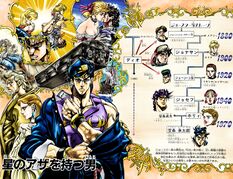
As três primeiras partes constituem uma trilogia depois da qual Hirohiko Araki planejava acabar a série, mas apesar disso JoJo's Bizarre Adventure continuou depois do fim da terceira parte.[6]
Diamond is Unbreakable
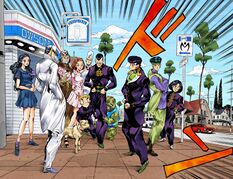
A quarta parte Diamond is Unbreakable é ambientada na fictícia cidade de Morioh, Japão, em 1999. Ela segue o filho ilegítimo de Joseph, Josuke Higashikata enquanto ele conhece novos amigos e inimigos dentro da população de Morioh criados com o Arco e Flecha, dois itens dos quais deram a DIO sua Stand. Ele, Okuyasu Nijimura, Koichi Hirose, Jotaro Kujo, e Rohan Kishibe eventualmente perseguem o assasino Yoshikage Kira.
Vento Aureo
Na quinta parte Vento Aureo, Ambientada na Itália em 2001, o filho de DIO, Giorno Giovanna combate seu caminho para chegar no topo da Passione, a mais poderosa gangue da Itália, enquanto ele planeja usurpar o mistérioso Chefe para proteger a população civil do tráfico de drogas da gangue. Para isso ele coopera com o membro de gangue Bruno Bucciarati e seu próprio time de Leone Abbacchio, Guido Mista, Narancia Ghirga, e Pannacotta Fugo como eles são encarregados de proteger a filha do chefe, Trish Una das equipes de assasinos Squadra Esecuzioni e Unità Speciale.
Stone Ocean
A sexta parte, Stone Ocean, é ambientada em 2011 enquanto a filha distanciada de Jotaro, Jolyne Cujoh é incriminada de homicídio e presa na Prisão Green Dolphin Street. Jotaro então tem ambas suas memórias e seu Stand roubadas pelo Stand Whitesnake depois de uma tentativa de libertar Jolyne. Ela então decide ficar imprisionada para descobrir quem é o Usuário de Whitesnake e o que ele planeja fazer com as memórias e Stand de Jotaro. Na sua jornada, Jolyne ganha aliados como Emporio Alnino, Ermes Costello, Foo Fighters, Narciso Anasui, and Weather Report.
Continuidade do Universo Alternativo
Steel Ball Run
Ambientada em 1890 nos Estados Unidos, Steel Ball Run segue uma corrida pelos Estados Unidos da América. A corrida é chamada de corrida de cavalos Steel Ball Run e é nomeada em honra do patrocinador, Steven Steel. Os protagonistas são Gyro Zeppeli, um mestre da única técnica do Spin atrás da recompensa em dinheiro e Johnny Joestar um ex-jóquei paraplégico procurando curar suas pernas através do Spin, ambos cooperando para vencer a corrida. Johnny e Gyro descobrem que a corrida é uma cobertura do Presidente Funny Valentine para descobrir as poderosas e inestimáveis relíquias de Jesus Cristo, eventualmente também caçando as faladas relíquias enquanto se esquivam dos muitos agentes de Valentine.
JoJolion
Pulando para o ano 2011 em JoJolion, estudante de universidade Yasuho Hirose descobre um homem amnésico tentativamente chamado "Josuke" em Morioh depois do (então contemporânea) Grande Terromoto do Leste do Japão. Ambos então decidm investigar a identidade passada de Josuke, inicialmente pensada ser do doutor naútico Yoshikage Kira, e as circunstâncias de sua presença na cidade, deixando-o sob os cuidados da afluente Família Higashikata enquanto os dois descobrem os segredos mais obscuros e um tráfico de drogas envolvendo uma misteriosa raça de seres humanoides e uma igualmente mistériosa fruta.
The second continuity features many nods to characters of the former continuity including restyled main characters, Stands and locations.
Parts
| No. | Title | Original Run | Volumes |
|---|---|---|---|
| 1 | 1987 – 1988 | 5 | |
| Beginning in 1880, Part 1 follows Jonathan Joestar as he matures with and eventually combats his adoptive brother, the cunning, merciless Dio Brando. | |||
| No. | Title | Original Run | Volumes |
|---|---|---|---|
| 2 | 1988 – 1989 | 7 | |
|
Set in 1938, Part 2 follows Joseph Joestar, grandson of Jonathan, who finds himself embroiled in a war against ancient super-beings named the Pillar Men, creators of the Stone Mask. | |||
| No. | Title | Original Run | Volumes |
|---|---|---|---|
| 3 | 1989 – 1992 | 16 | |
| Part 3, set in 1989, follows Jotaro Kujo, who has acquired the power of Stand, and his allies as they journey from Tokyo to Cairo to save his mother's life by defeating his family's archenemy, DIO. | |||
| No. | Title | Original Run | Volumes |
|---|---|---|---|
| 4 | 1992 – 1995 | 18 | |
|
In Part 4, set in 1999 in the fictional town of Morioh, high-schooler Josuke Higashikata and his friends seek out the Arrow, which has the power to give Stand abilities, as well as the serial-killer Yoshikage Kira. | |||
| No. | Title | Original Run | Volumes |
|---|---|---|---|
| 5 | 1995 – 1999 | 17 | |
| Part 5, set in Italy in 2001, follows the adventure of Giorno Giovanna, the son of DIO, in his ambition to rise within the Italian mafia by subverting the dominant gang Passione and its mysterious Boss with the aid of a team of fellow Stand users. | |||
| No. | Title | Original Run | Volumes |
|---|---|---|---|
| 6 | 2000 – 2003 | 17 | |
|
In Part 6, 2011, Florida, Jolyne Cujoh, daughter of Jotaro Kujo, is framed for murder and thrown in the Green Dolphin Street Prison. She and her allies struggle to discover who is responsible for what and what are they planning to do. | |||
| No. | Title | Original Run | Volumes |
|---|---|---|---|
| 7 | 2004 – 2011 | 24 | |
|
Beginning another continuity, Part 7 follows Gyro Zeppeli, master in a mystic art named the Spin, and Johnny Joestar, a paraplegic ex-jockey, as they compete with a vast number of others in the highly rewarded Steel Ball Run race in the U.S. in 1890, designed in part by the American government. | |||
| No. | Title | Original Run | Volumes |
|---|---|---|---|
| 8 | 2011-Ongoing | 25 | |
|
Part 8 begins in 2011 and follows Josuke Higashikata, a young man afflicted by retrograde amnesia, on his search to uncover his identity in Morioh, a coastal Japanese town affected by the Tohoku earthquake. | |||
Publication
Chapters are serialized in Weekly Shonen Jump and Ultra Jump, under Shueisha. While in Weekly Shonen Jump, the series was published under the tagline "Romantic Horror! -A Crimson Tale-" (ロマンホラー!—深紅の秘伝説—, Romanhorā!-Shinku no hi densetsu-). The tagline was created by the editorial department at Shueisha and was included in every chapter up until Stone Ocean.
In North America and the United Kingdom, Stardust Crusaders was translated into English and published in 16 volumes by VIZ Media from November, eighth 2005 to December 7, 2010 under the title of JoJo's Bizarre Adventure, skipping both Phantom Blood and Battle Tendency. On June 9, Viz Media published the first three parts of JoJo's Bizarre Adventure from the JoJonium line of manga, from February 24, 2015 to February 5, 2019, marking the first English publications of Phantom Blood and Battle Tendency. On July 6, 2018, Viz Media announced they would be releasing an English publication of Diamond is Unbreakable. The first volume of Diamond is Unbreakable was released on May 7, 2019. Diamond is Unbreakable is still currently being released.
In Italy, Star Comics began publishing the series in a monthly format under the title Le Bizzarre Avventure Di JoJo from November 1993 to April 2004,[7] these monthly releases contained around five chapters in each trade paperback with 126 paperback volumes released. These releases would then be followed up in March 2006 with translations of the Steel Ball Run volumes that were published until February 2012. During this time, Star Comics published the JoJo's Bizarre Adventure (Bunko Edition) volumes with their Italian translation of the series starting from 2010. Currently, they have been publishing JoJolion since February 2014 and have begun releasing the JoJonium volumes since October 2019 with further releases still on-going.
In France, the first four parts were published by J'ai lu[8] from January 2002 to December 2005. In 2007 publisher Tonkam (now a subsidiary of editions Delcourt resumed the publication of the following parts starting with a publication of Vento Aureo, the previous parts would later see revised releases under Tonkam's publication starting with Stardust Crusaders and then going back to Phantom Blood and continuing from there. Currently, they are publishing JoJolion.[9]
In Spain, the entire series is being published by IVREA. Phantom Blood started publication on June 30, 2017. This publication uses the same volume count as the Bunko Edition volumes, these volumes come out monthly. They are currently publishing Stone Ocean as part of their publication.
In Argentina, the first four parts are being published by IVREA Argentina.
In Mexico, the first five parts are being published by Panini. Publication started on August 1, 2018 with Phantom Blood using the same volume count as the Bunko Edition volumes, these volumes come out monthly. The current part in publication is Diamond is Unbreakable.
In Brazil, the first three parts are being published by Panini.
In China, JoJo was illegally distributed under the title Strongman Front (強人陣線) by Tong Li Comics for many years until Daran Comics obtained the official publishing license for JoJo, renaming the comic JoJo Adventure Wild (JoJo冒險野郎). On March 31, 2003 Daran Comics shut down their offices and their license for JoJo was officially obtained by Tong Li Comics who now officially distributes the series in Taiwan and reverted the title of the series back to JoJo's Bizarre Adventure (JoJo的奇妙冒險). Currently, the series is being published by World Publishing Limited as they are currently releasing a publication of JoJolion.[10]
In Poland, the series is being published by J.P.Fantastica. Publication started in May 2020 with Phantom Blood using the same volume count as the JoJo's Bizarre Adventure: Shueisha Comic Bunko. The current part in publication is Battle Tendency.
Making-of
When he first conceived JoJo's Bizarre Adventure, Araki was throwing around several core ideas he wanted to portray such as an idea of succession between generations, but also to show travelling heroes. From there he began to set up his ideas for Phantom Blood. Araki notes that the process of creating JoJo went from fight to a more spiritual aspect, and that concepts like friendships took a greater place over time.[11] Araki had several themes in mind too, such as the idea of "mystery",[12] and notably the mystery coming from bloodlines. He also asked himself "Who is the strongest person in the world?" and derived from this question themes such as immortality, seeking life, or justice.[12] More importantly, Araki felt that he could create something unique among the current series at Weekly Shonen Jump with these ideas. Araki had initially only planned for three parts,[13] but decided to continue with his series.
Writing JoJo
Araki gives precedence to emotion and inner thought over plot structure, trying to portray the protagonists' destiny.[14]
Araki follows a particular narrative style called the "golden road", characterized by strong and determined protagonists who constantly advance towards their objectives. This "golden road" is, according to him, the best way to draw in the audience. One example of his "golden road" is the plot of Stardust Crusaders during which the heroes always manage to defeat the enemies on their paths and inexorably approach Egypt. Araki is not avert to killing off his protagonists like Jonathan Joestar but feels that if the death served a greater purpose then he still abides by the "golden road".[15] Araki thinks the basic plot of his parts around a particular predicament and likes to throw his protagonist quickly into said predicament before continuing off his story from there (e.g. Johnny Joestar is paraplegic and wants to find a way to heal his legs).[15] Araki also use a rather original plot structure for the series. Instead of the classical "tournament" format of most other series at the time where the heroes fought enemies in a predictable increasing order of strength, Araki adopted a sugoroku style (sugoroku is a table-top game similar to snakes and ladders) where the heroes would travel and then meet enemies at particular points in said journey and the fights would be more varied due to a better variety of powers, and an emphasis on wit rather than force.[16] Araki also denounces the long-term limitations of always increasing the strength of enemies in a serialized manga.[17][12]
Araki takes inspiration from a variety of sources to write his series. He has confirmed several times that he uses Western music to name his characters, but also copies designs from varied sources such as artbooks, comic books, the news, or movies. Araki extensively uses books rather than online research.[18] One lesser known aspect of his research is that he often travels to the places he depicts in the series in order to have a better feeling of the place and gather details that an online research wouldn't give. His first tanto Ryosuke Kabashima encouraged him to see movies for inspiration and also travel.[19] Kabashima notably coerced Araki into travelling to Egypt to later depict it in Stardust Crusaders.[20] Araki would later on keep this habit and went to Italy for Vento Aureo[21] and went to a correctional facility in Florida too to get inspiration for Green Dolphin Street Prison,[22][23] as well as Orlando.[24] He also went on several long journeys in the USA and Japan to better write Steel Ball Run too.[25] His habit of travelling to research places extended to individual buildings such as a hospital or a drug store.[26]
Araki makes it a point to never rest on his laurels and always find new ideas. For instance, Araki was displeased to think he had reached a summit with Stone Ocean in terms of idea and had decided to erase the original continuity and revisit his old ideas in a second continuity.[27] His will to always change is also notable on his art (though he explains it as avoiding drawing old art rather than deliberately change).[28] Araki's art style has changed considerably over the years, although he had always kept core ideas about his art such as his dramatic poses and representation of an ideal human body. For instance, muscle-bound heroes were popular in the 80s so Araki drew these types of characters (e.g. Jonathan), but as trend changes, Araki transitioned to more normal-looking characters like Giorno, a slimmer pretty boy character type.[29][11] The unusual sound effects Araki inserts in his page are inspired from horror movies and rock music, akin to scare chords and other noises produced by synthetizers and mellotrons.[29]
During its publication in the Weekly Shonen Jump magazine, Araki continuously tried to push for unique ideas, often infringing on what was considered acceptable for the magazine. Araki notably decided to make his first protagonist a foreigner and then kill him off to replace him, which was a taboo. Araki also had tried to write female protagonists for the series, with notably Giorno Giovanna being initially thought as a young woman. This would be eventually portrayed with Jolyne Cujoh, whose sex he insisted on despite his editor's requests. Araki notably thought that it was then acceptable to portray women being subjected to violence as intense as male characters were being exposed to.[30][29] It led to several conflict with the editorial team who tried to tone down the violence and themes Araki wanted to write about.[31]
When Araki creates a character, he thoroughly completes a datasheet about said character, which includes their physical characteristics, their tastes, and background information like a potential family.[32] Araki notes that his habit of naming characters after bands and albums is a simple hobby, and a way to pay his respect to the musicians he likes.[12]During his time at the Weekly Shonen Jump, Araki had the following schedule: Sundays were spent finding ideas, Mondays were spent making the draft storyboard for the chapter. He then met with his editor and began drawing more elaborate sketches, one page at a time. Tuesday, Wednesday and Thursday were spent finishing drawing the chapter for the publication of the Weekly Shonen Jump magazine, and Friday and Satudary were spent resting.[33] This schedule that Araki followed strictly was set up by Kabashima too.[19] This notably allowed Araki to keep in shape, and he was also noted as being always on time for his chapters.[34]His currently monthly schedule seems to have stayed the same as his weekly schedule, with Fridays and Saturdays off. Araki adds that he wakes up at 10 AM, begins working at 11 AM, takes a break at noon, and finishes his work day at 12 PM.[35] Araki says that his current 45 pages a month match his natural pace better.[18] Thanks to his strict schedule, Araki has never missed a deadline in his career.[18][34]
Trivia
- List of cultural references in JoJo's Bizarre Adventure
- List of cultural references and inspirations from JoJo's Bizarre Adventure
- The 25th year of JoJo's continuous publication is commemorated in part by a booklet titled 25 Years With JoJo, featuring fan art by mangakas including Eiichiro Oda, Akira Toriyama, and Osamu Akimoto.
References
- ↑ Nota: A primeira edição foi lançada em lojas em 2 de Dezembro de 1986 - Weekly Shonen Jump #940 - No. 1-2, 1987
- ↑ http://www.araki-jojo.com/1151/
- ↑ Morioh Map (JoJolion)
- ↑ [Pergunta para Araki-sensei! (13): "Se você pudesse descrever JoJo em uma só palavra"] - comipress.com, 2007
- ↑ [Question for Araki-sensei! (9): "If You Can Describe Manga in A Single Word"] - comipress.com, 2007
- ↑ JoJonium Special Interviews: Volume 8, Jotaro Kujo
- ↑ https://it.wikipedia.org/wiki/Le_bizzarre_avventure_di_JoJo First Italian release November 1993
- ↑ http://fr.wikipedia.org/wiki/J%27ai_lu
- ↑ https://www.editions-delcourt.fr/auteur/araki-hirohiko.html
- ↑ [1] Chinese Wikipedia page for the JoJo series
- ↑ 11.0 11.1 Animeland Interview 06/2003
- ↑ 12.0 12.1 12.2 12.3 Tokai Lecture 06/2006
- ↑ Weekly Shonen Bracket 100Q
- ↑ Tokai Lecture 06/2006
- ↑ 15.0 15.1 Hirohiko Araki's Manga Technique chapter 4
- ↑ NYT Japan interview 11/2018
- ↑ Volume 45, Volume 46 Author's note
- ↑ 18.0 18.1 18.2 Dream Talk Sessions 2015
- ↑ 19.0 19.1 JOJOVELLER History 1979-2013
- ↑ Manga Heaven 06/2007
- ↑ Author's Note (Vento Aureo) vol.48
- ↑ SO Volume 1 special thanks
- ↑ SO Volume 5 Author's Note
- ↑ SO Volume 12 Author's Note
- ↑ P7 Bunko 1 afterword
- ↑ Volume 41 Author's Note
- ↑ P6 Bunko Vol.11 Afterwords
- ↑ JOJOmenon interview
- ↑ 29.0 29.1 29.2 PS2 Game interview
- ↑ P6 Bunko Vol.1 Afterwords
- ↑ P5 Bunko Vol.1
- ↑ Manga in Theory and Practice chapter
- ↑ JoJo6251 Araki interviews
- ↑ 34.0 34.1 JOJOVELLER 2013 Azuma interview
- ↑ https://jojowiki.com/Interview:Asahi_Shinbun_(September_2013)
<languages/>

